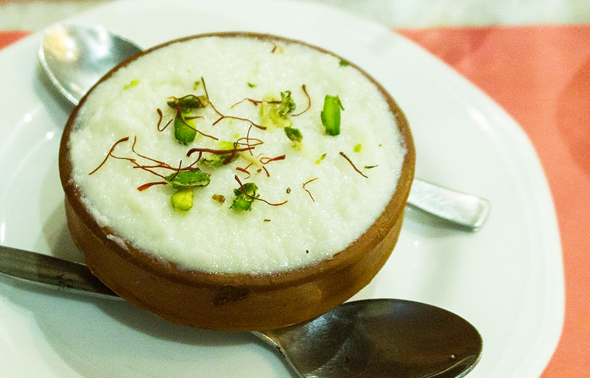Mama’s Punjabi Recipes: Rabri (Sweetened Coagulated Milk)
Saved under Community, Current Stories, Recipe Corner
Tags: Baytown, Clear Lake, Cypress, Desi news, Greater Houston, Houston, Houston Desi news, India, Indian American community, Indian News, Indians in America, Indo-American News, Katy, Mama’s Punjabi Recipes, NRI, pearland, Rabri, Shakuntla Malhotra, south asia, South India, Sugar Land, Sweetened Coagulated Milk, Texas, USA
Rabri (Sweetened Coagulated Milk) is the ultimate Indian sweet dish as it is made from milk and is the first step to making several other desserts too like khoya, rasmalai, barfi and milk cake. It is also very time consuming as the milk has to slowly boil over low heat to evaporate till it becomes thick and turns pinkish and you have to constantly stir it so that the milk does not get brown at the base. This requires a lot of patience and stamina to stand beside a hot stove and stir the milk. As few people have such spare time, this recipe I am presenting is faster thanks to a convenient short cut.
There is a version called Calcutta Rabri or Lachedar (meaning collected folds) Rabri which is made in a wide open kadai (wok) by collecting the boiled off cream that forms on the top and keeping it off to the side in layers until the milk is exhausted. The rabri so formed is very creamy and heavy on the stomach. Gujarati basundi is a variant of this method, except the cream is mixed into the milk to create little specs.
When my sons were very young, everytime I used to make rabri (sweetened condensed milk), they would fight to see who would get a chance to clean off the inside of the pot in which it was made! I would have to set aside a little for both in a small bowl to pacify them!
A word of caution. Just like many other Indian sweet dishes, rabri is very rich in calories and is very heavy to digest, so it is best not to eat too much of it at one sitting, although you will find it very hard to resist! Although some people try to make it with low fat cream or milk, you can immediately tell the difference in taste.
Ingredients:
• 1/2 gal (2 liters) saada doodh (whole milk)
• 1/2 cup badam (almonds) – blanched and slivered
• 1/2 cup piste (pistachios) – sliced into halves
• 1/2 can (7 oz) sweetened condensed milk
• To taste: illachi (cardamom) powder
Directions:
1. Pour the milk into a large pot with a heavy bottom or a broad faced kadai (wok) and place over medium heat to boil.
2. After the milk has come to a boil, turn the heat down to low and then stir it continuously so that it does not stick to the bottom.
3. Continue to boil and stir the milk till it starts to thicken up and has reduced to half its volume. Scrape off the cream stuck to the sides and let them fall into the dish.
4. Throw in the badam and piste and continue to stir the milk.
5. Pour in the condensed milk and stir well for 5 minutes.
6. Turn the heat off and let the rabri cool down.
7. Transfer into a serving dish and place in the fridge to cool down and thicken further. Sprinkle with the illachi powder and serve.
MAMA’S TIP OF THE WEEK: NUTRIENTS FOR PLANTS FROM EGG SHELLS!
I was surprised to see a relative of mine who had thrown in some broken egg shells onto the soil of a potted plant in her house because she had heard that it would help it to grow. It seemed unsightly but she claimed it worked.
I did some checking of my own and found that the egg shells are rich in calcium, phosphorous, magnesium and potassium, all have nutrients that plants love. But rather than throw broken egg shells in, collect the egg shells in a bowl and let them dry in the sun. Afterwards, smash the shells and pulverize them in a mortar and then till the powder into the soil to absorb the nutrients over time. The plants will really start to blossom, but don’t place in the holy tulsi plant! A layer of crushed egg shells also protects against snails and slugs!

Shakuntla Malhotra is a skilled cook of Punjabi dishes made in the old-fashioned style that she learnt as a young woman in her ancestral home in Lyallpur, India (since renamed Faisalabad) before it became part of Pakistan after the Partition in 1947. People have often admired her cooking for its simplicity and taste that comes with each mouthful. Even in her late-eighties, she continues to cook daily and agreed to share her delectable Punjabi vegetarian recipes for future generations.

